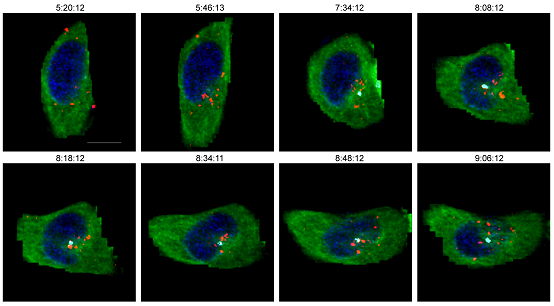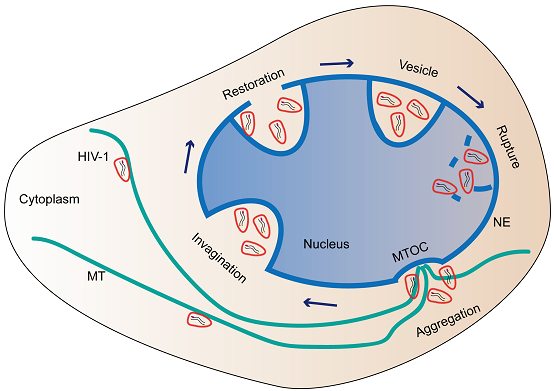CAS Zhang Xian-En Team Discovers HIV-1 Virus Cores Can Enter Cell Nucleus
On May 15, Science China-Life Sciences published a study online showing that HIV-1 viral cores can enter a cell nucleus collectively through the nuclear endocytosis-like pathway. For the purpose of this research, the team made their observations by combining cellular molecular imaging and electron microscopy.
It is conventionally acknowledged that HIV-1 infects cells in the following steps: membrane fusion, viral core release, reverse transcription, CA disassembly in cytoplasm, nuclear entry of the viral genome, and viral genome integration. This process is followed by cells’ reproducing themselves using the host cell system. Nevertheless, recent research shows that viral capsida, integrating site selection and immune escape, does exist in virus cores. According to new studies, uncoating occurs near the chromosomal integration site. Because the size of the coated virus core is far larger than the nuclear pores, it is increasingly a focal point in research to understand how virus cores pass through the nuclear membrane.
To address this issue, the team differentiated between the labeling of the components of virus and host cells in order to track their interactions in a dynamic manner. The result shows that virus particles, after entering the cells, move along the microtubules and gradually gather at the microtubule organization center (MTOC), causing the nearby nuclear membrane to form invagination, which is the entry point for the virus particles. Following the ESCRT-III system, the deformed nuclear membrane undergoes restoration to form a nuclear vesicle in which the viral particles are wrapped. Then the inner membrane of the nuclear vesicle ruptures to release HIV-1 particles into the nucleus. As the virus moves along the microtubules for gathering at the core, use of a microtubule inhibitor can eliminate the above phenomenon, which is similar to cell endocytosis and is therefore called a "nuclear endocytosis-like pathway". This study reveals the mechanism and expands the understanding of the complexity of HIV-1 virus cores entering the nucleus, which may provide new insights to HIV-1 virology. The molecular details and viral biology of the mechanism need further elucidation.
First author Li Xia is a doctoral candidate under a joint program by the Institute of Biophysics (IBP) of the Chinese Academy of Sciences (CAS) and the School of Public Health of Tongji Medical College at Huazhong University of Science and Technology. Zhang Xian-En and Zhou Yi are correspondence authors. The CAS Wuhan Institute of Virology and Shenzhen Institutes of Advanced Technology contributed to the research. This work was supported by the Strategic Priority Research Program of the Chinese Academy of Sciences (XDB29050100).


Fig. 2: Model of HIV-1 nuclear entry
(The image by Dr. ZHANG Xian'en's lab)
The web link for this paper is http://engine.scichina.com/doi/10.1007/s11427-020-1716-x
Contact: ZHANG Xian'en
Institute of Biophysics, Chinese Academy of Sciences
Beijing 100101, China
Phone: 86-10-64888148
Email: zhangxe@ibp.ac.cn
(Reported by Dr. ZHANG Xian'en's group)

